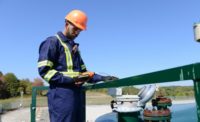A DOL Blog post
Working in workplace safety

Ensuring safe and healthy workplaces is a top priority of the Labor Department. It’s also a smart career path for people interested in making sure offices, factories, mines and other workplaces are safe from hazards and adhere to regulations concerning health, safety and the environment.
The median wages for all of these jobs are also higher than the median wage for all occupations ($36,200). Here’s a closer look at nine options:
Occupation - May 2015 Median Annual Wages
Mining and geological engineers, including safety - $94,040
Health and safety engineers, except mining - $84,600
Nuclear technicians - $80,260
Transportation inspectors - $70,820
Occupational health and safety specialists - $70,210
Construction and building inspectors - $57,340
Fire inspectors and investigators - $56,730
Occupational health and safety technicians - $48,070
Agricultural inspectors - $43,380
- Occupational health and safety specialists examine workplaces for environmental or physical factors that could affect employee health, safety, comfort and performance. This might mean reviewing workplace conditions such as lighting and air quality, and examining equipment and materials for potential hazards. They typically need a bachelor’s degree in occupational health and safety or in a related scientific or technical field to enter the occupation.
- Occupational health and safety technicians work closely with specialists to collect data, conduct tests, and take samples and measurements as they inspect workplaces. Technicians typically need at least a high school diploma or equivalent as well as on-the-job training.
- Health and safety engineers develop procedures and design systems to keep workers from getting sick or injured and to protect property from damage in various industries, including manufacturing, construction and government. They typically need a bachelor’s degree in an engineering field or in occupational or industrial hygiene.
- Mining safety engineers are a type of mining and geological engineer. They inspect mining equipment and the mines themselves for hazards, and take samples of air quality. A bachelor’s degree in mining engineering or a related field is usually needed.
Other jobs involved in health and safety do not have worker safety as their primary function, but still inspect and monitor workplaces or equipment to contribute to the health and safety of workers and the general population.
- Nuclear technicians mostly work in nuclear power plants, where among their duties they measure radiation both inside and outside the power plant to ensure it remains within safe limits. They typically need an associate degree to enter the occupation, or may have experience from serving in the military.
- Construction and building inspectors review building plans and monitor worksites to ensure building codes, regulations, and zoning laws are met. They not only inspect buildings but also structures such as bridges or sewer and water systems. Their inspections not only help to keep dwelling and structures safe for the population to use; they also help to ensure the safety of the workers that build them. They typically need a high school diploma or equivalent and previous work experience in construction.
- Transportation inspectors inspect vehicles, equipment, or cargo to ensure safety in modes of transportation such as air or rail. They may inspect airplanes, buses, or railroad cars and tracks, helping to keep operators and passengers safe. A high school diploma or equivalent and on-the-job training lasting less than 1 year is usually needed.
- Fire inspectors examine buildings to detect fire hazards and ensure that federal, state and local fire codes are met. Their inspections of factories, office buildings and other places where workers are located help keep those workers safe. They typically have previous experience as an emergency medical technician (EMT), firefighter or police officer, and usually some postsecondary education such as a nondegree award.
- Agricultural inspectors not only inspect food but also the equipment used to process it and the facilities where the processing takes place. They also inspect fishing and logging operations. Their primary function is to help protect the population from harm, such as from consuming food produced in unclean facilities. Their work, however, also contributes to the health and safety of workers, since they may prevent them from working in unsanitary workplaces or using unsafe processing procedures. Some jobs may need a bachelor’s degree and others a high school diploma or equivalent with work experience.
All of these occupations are projected to have job openings (including new jobs and jobs to replace workers leaving the occupations) from 2014 to 2024. Leading the list is construction and building inspectors with 36,300 projected job openings.
Occupation - Job openings due to growth and replacements, 2014-24
Construction and building inspectors - 36,300
Occupational health and safety specialists - 16,900
Health and safety engineers, except mining - 9,000
Transportation inspectors - 7,100
Occupational health and safety technicians - 4,400
Fire inspectors and investigators - 4,300
Agricultural inspectors - 3,600
Nuclear technicians - 2,800
Mining and geological engineers, including safety - 2,700
Editor's note: Job openings include new jobs as well as jobs to replace workers who permanently leave the occupations.
Explore all of these occupations and many more in the Occupational Outlook Handbook.
Looking for a reprint of this article?
From high-res PDFs to custom plaques, order your copy today!









